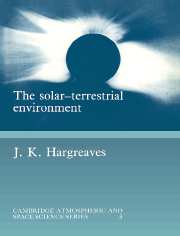 The Solar-Terrestrial Environment
The Solar-Terrestrial Environment Book contents
- Frontmatter
- Contents
- Preface
- 1 The Earth in space
- 2 The physics of geospace
- 3 Techniques for observing geospace
- 4 The neutral atmosphere
- 5 The solar wind and the magnetosphere
- 6 Principles of the ionosphere at middle and low latitudes
- 7 Ionospheric phenomena at middle and low latitudes
- 8 The ionosphere at high latitude
- 9 Magnetospheric waves
- 10 Technological application of geospace science
- Index
10 - Technological application of geospace science
Published online by Cambridge University Press: 29 January 2010
- Frontmatter
- Contents
- Preface
- 1 The Earth in space
- 2 The physics of geospace
- 3 Techniques for observing geospace
- 4 The neutral atmosphere
- 5 The solar wind and the magnetosphere
- 6 Principles of the ionosphere at middle and low latitudes
- 7 Ionospheric phenomena at middle and low latitudes
- 8 The ionosphere at high latitude
- 9 Magnetospheric waves
- 10 Technological application of geospace science
- Index
Summary
‘I see you're admiring my little box’, the Knight said in a friendly tone. ‘It's my own invention – to keep clothes and sandwiches in. You see I carry it upside-down, so that the rain ca'n't get in.’
Lewis Carroll, Through the Looking Glass (1871)Introduction
Science and engineering are related activities with different objectives. The purpose of science is to gain knowledge, and the essence of scientific achievement is intellectual rather than practical. To a scientist the knowledge and the ideas are what matter most. Engineering, on the other hand, is all about practical things. The result of successful engineering endeavour is a machine, a device or a scheme for performing some specific task. What matters to the engineer is that the machine, device, etc., should work well, and he/she will draw on any area of knowledge or experience to achieve this. Some of that knowledge might be science based; some might not.
Having drawn the distinction, we should at the same time recognize that there are strong links between these activities. Science relies on instruments and computers, the products of the engineer, and it should be abundantly clear from Chapter 3 how much the progress of geospace has depended on the development of techniques. And although there is no law that engineering must be science based, it draws heavily on scientific knowledge in practice. It would be an unusual engineer who relied entirely on historical practice or intuition. It is the purpose of this chapter to consider the impact of geospace science on practical activities within the province of the engineer.
- Type
- Chapter
- Information
- The Solar-Terrestrial EnvironmentAn Introduction to Geospace - the Science of the Terrestrial Upper Atmosphere, Ionosphere, and Magnetosphere, pp. 390 - 414Publisher: Cambridge University PressPrint publication year: 1992
- 1
- Cited by
